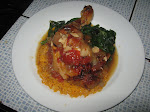But please, please, please don't get the idea that we weren't/aren't ready for it. That's hardly the case. Here on the home front we've filled the woodpile with 4 cords of of firewood, harvested most of the garden and canned, roasted, dried and frozen just about everything that could possibly be of some use in the coming months of chill.
We have made the short drive back and forth to Ted Hazel's massive woodpile (he's a local woodcutter) in the White Buffalo, our 1990 Chevy Cheyenne pick-up with load after load of firewood. We'd pick it up at his place and hurl (or occasionally neatly stack) it into the bed of the truck then drive it up the hill here to our house where we once again hurl it out onto the lawn in preparation for the meticulous stacking process. This wood gets handled a lot.
I'm new at this, but Kathy has a plan and a system, and it's a good one, involving building strong corners using half logs and then stacking and arranging the rest in between. We've managed to get 4 cords of wood stacked into a relatively small area and it's pretty damn impressive. Just one cord of wood is, as I have learned, 4 feet by 4 feet by 8 feet, or, 128 cubic feet, and that's a lot of wood. Multiply that times four and you get a big old (neatly organized) pile of wood.
Each of our runs over to Ted's netted us about 1/4 of a cord, so there were 16 trips and then a number of afternoon stacking parties to get all this fuel into place. We heat our house with a wonderful old cast iron stove and it beats the heck out of paying a $300 month electrical bill, no matter how tired one gets of hauling and stacking firewood.
And just past the woodpile is the garden, which has been very nearly picked clean. Our early crops were potatoes, onions and garlic, all of which were picked and stored in the shed last month; but the most recent harvest has been tomatoes, green beans, peppers and a few squash.
If you'd asked me a month ago whether or not we were going to have ripe tomatoes, any ripe tomatoes, I would have had to tell you no, I didn't think so. All it took was three hot weeks from the end of August into the second week of September, and we've got almost more red, ripe tomatoes than we know what to do with, BUT, the good news is, we do know what to do with them. Kathy is a drying expert and we now have ten or twelve giant zip-locs filled with dried tomatoes for winter sauces and stews.
My preferred method of storage is a newer one that I developed a few years ago when trying to wrench flavor out of winter tomatoes while working in San Francisco. My technique involves pouring olive oil on a sheet pan, placing cored and halved tomatoes on it (cut side down), layering thick slices of onion and whole cloves of garlic in and around the tomatoes, pouring on more olive oil and then salting and peppering. The tray of tomatoes is roasted in a 400-450 degree oven until the tops blister and then removed and allowed to cool. I rough chop the roasted tomatoes and store them and all their luscious juices in yet more zip-locs. The tomatoes get a tremendous concentration of flavor (thus, my having used this technique on flavorless winter tomatoes) and can be used for pasta sauces, or added to braises and stews for more flavor. I love this technique.
We have eaten as many green beans as we could possibly shove into the front of our faces, and now they just get quick blanched and frozen for winter usage. We used the same technique for an earlier harvest of peas and now have four bags full. Kathy freezes chiles whole and it seems to be a pretty good idea. We have zip-locs filled with anaheim, poblano and jalapeno chiles stored in the freezer for future reference. There are still Walla Walla onions to be pulled and a scant number of pumpkins "oranging" in the last of the September sun. We had some kind of funky fungus that got to most of our zucchini, but then again, that may have been more a blessing than a curse. And last week we ate our last head of romaine so despite there not having been any summer at all until early August, I think we did pretty damn well.



























































